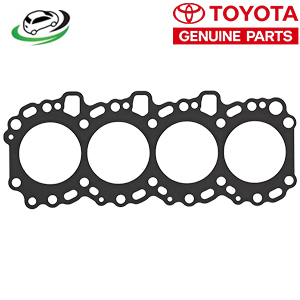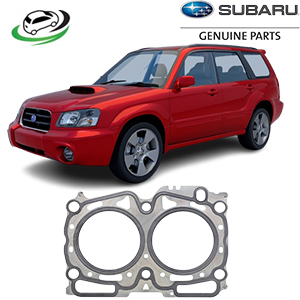-6%
Get Subaru Forester SG5 Cylinder Head Gasket Assy 11044AA680
The cylinder head gasket assembly is a critical component in any internal combustion engine. It forms a vital seal between the engine block and the cylinder head, preventing leaks of engine fluids and ensuring optimal compression in the combustion chamber. The reliability of the head gasket assembly is essential for the engine’s proper functioning, as a failure in this part can lead to significant performance issues and potentially catastrophic engine damage. In this comprehensive guide, we will explore the functions, materials, types, installation process, common issues, and maintenance of the cylinder head gasket assembly.
1. Function of a Cylinder Head Gasket Assembly
The cylinder head gasket assembly performs several essential functions within an engine:
- Sealing the Combustion Chamber: The gasket assembly forms a tight seal around the combustion chamber, preventing the leakage of gases produced during the combustion process. This seal is crucial for maintaining engine performance and efficiency, as any loss of compression will lead to a reduction in power output.
- Separating Fluids: The engine relies on multiple fluids, including oil and coolant, to operate efficiently. The head gasket ensures that these fluids do not mix by providing a barrier between the engine’s oil passages and the cooling system. Mixing of coolant and oil can result in severe damage to internal engine components, making the gasket’s sealing ability critical.
- Maintaining Compression: The head gasket helps maintain the compression ratio required for efficient combustion. A loss of compression due to a faulty gasket can lead to engine misfires, reduced power, and poor fuel economy.
- Heat Management: In modern engines, the cylinder head gasket also plays a role in managing the distribution of heat between the engine block and the cylinder head. Proper heat distribution helps prevent overheating and ensures the engine runs at optimal temperatures.
2. Types of Cylinder Head Gaskets
There are several different types of cylinder head gaskets available, each designed to meet the specific demands of various engine configurations. The most common types include:
- Multi-Layer Steel (MLS) Gaskets: MLS gaskets are the most common type used in modern engines. They are made from several layers of steel with a coating that helps create a durable, flexible seal. MLS gaskets are known for their ability to withstand high-pressure and high-temperature environments, making them ideal for high-performance and turbocharged engines.
- Composite Gaskets: Composite head gaskets were commonly used in older engines and are made from a combination of materials such as asbestos (now replaced with safer materials) and graphite. Composite gaskets are cheaper to produce but tend to be less durable than MLS gaskets, making them less common in modern vehicles.
- Copper Gaskets: Copper gaskets are often used in high-performance and racing applications due to their excellent heat conductivity and sealing ability. However, copper gaskets require precise installation and are more expensive than other gasket types.
- Elastomeric Gaskets: These gaskets use a combination of rubber-like materials (elastomers) and steel or fiber-reinforced materials to create seals around critical areas such as coolant and oil passages. Elastomeric gaskets are known for their flexibility and ability to provide extra sealing protection in specific areas.
The choice of gasket type depends on the engine’s design, operating conditions, and the vehicle manufacturer’s specifications.
3. Materials Used in Cylinder Head Gaskets
Head gaskets are typically made from materials that can withstand high pressure, temperature, and chemical exposure. The most common materials include:
- Steel: Multi-layer steel (MLS) gaskets use thin layers of steel combined with rubber coatings. Steel offers excellent durability, resistance to corrosion, and the ability to handle high levels of pressure without warping or failing.
- Graphite: Graphite gaskets offer flexibility and the ability to conform to uneven surfaces, which is useful in older engines or where the engine block may have imperfections. Graphite is also resistant to high temperatures, making it suitable for use in engines that run hotter.
- Copper: Copper gaskets provide superior heat conductivity and sealing but are typically reserved for performance applications. They offer excellent sealing capabilities but require careful installation due to their tendency to deform under pressure.
- Elastomers: Elastomeric materials are used in combination with steel or fiber-reinforced materials to create seals around fluid passages. These materials are flexible and can help improve sealing in high-stress areas.
4. Signs of a Failing Cylinder Head Gasket
A failing head gasket can cause severe engine problems if not addressed promptly. Some of the most common signs of head gasket failure include:
- Overheating: Engine overheating is a common symptom of head gasket failure. When the gasket is damaged, coolant may leak out or into the combustion chamber, causing the engine to overheat due to a lack of coolant.
- White Smoke from the Exhaust: White smoke from the exhaust is often a sign that coolant is entering the combustion chamber, indicating a blown head gasket. The coolant vaporizes during combustion and exits through the exhaust as white smoke.
- Milky Oil or Coolant: If the head gasket fails, it can allow coolant and oil to mix. This creates a milky, frothy substance in the oil, which can be seen on the oil dipstick or inside the oil cap. Contaminated oil cannot properly lubricate the engine, leading to severe damage.
- Loss of Power: A damaged head gasket can cause a loss of engine compression, leading to reduced power output and poor fuel efficiency. The engine may also misfire or have difficulty starting.
- Coolant Leaks: External coolant leaks near the cylinder head are another sign of a potential head gasket problem. If coolant is visibly leaking around the engine block or cylinder head, the gasket may need to be replaced.
- Bubbles in the Radiator: Exhaust gases leaking into the cooling system can cause bubbles to appear in the radiator or coolant overflow tank. This is a sign that the head gasket is not maintaining the proper seal.
5. Installation of a Cylinder Head Gasket Assembly
Replacing a head gasket is a complex and labor-intensive task that typically requires professional expertise. The steps involved in installing a new cylinder head gasket assembly include:
- Disassembly: The engine must be partially disassembled to access the cylinder head. This involves removing the intake manifold, exhaust manifold, timing components, and other accessories.
- Cylinder Head Removal: Once the engine components are removed, the cylinder head is detached from the engine block. Care must be taken to avoid damaging the cylinder head during this process.
- Surface Preparation: Before the new gasket is installed, the surfaces of the engine block and cylinder head must be thoroughly cleaned and inspected for damage. Any warping, cracks, or other imperfections must be addressed, either by machining or replacing the affected parts.
- Gasket Installation: The new head gasket is carefully placed on the engine block, ensuring that all alignment dowels and holes match up with the corresponding components.
- Reassembly: After the new gasket is installed, the cylinder head is reattached, and the engine components are reassembled. Proper torque specifications must be followed when tightening the cylinder head bolts to ensure a secure seal.
- Testing: Once the engine is reassembled, it is tested to ensure that the new head gasket is sealing properly and that no leaks or compression issues are present.
6. Prevention and Maintenance Tips
While head gasket failures can sometimes be inevitable due to age or high mileage, there are several steps you can take to reduce the risk of a blown head gasket:
- Regular Cooling System Maintenance: Keep the cooling system in good working order by regularly checking coolant levels and replacing coolant as needed. Overheating is one of the primary causes of head gasket failure, so ensuring the cooling system is functioning properly is essential.
- Monitor Engine Temperature: Always keep an eye on the engine’s temperature gauge. If the engine begins to overheat, shut it down immediately to prevent further damage.
- Use the Correct Engine Oil and Coolant: Using the right fluids for your engine helps ensure proper lubrication and cooling. Always use manufacturer-recommended oil and coolant.
- Address Misfires and Engine Issues Promptly: If the engine is misfiring or running poorly, address the issue immediately. Ignoring these symptoms can lead to further damage, including head gasket failure.
- Avoid Aggressive Driving: High-performance driving, such as hard acceleration and frequent heavy loads, can increase stress on the engine and the head gasket. Avoid pushing the engine beyond its limits to extend the life of the head gasket.
7. Benefits of a Genuine Cylinder Head Gasket
Choosing a genuine cylinder head gasket offers several benefits:
- Perfect Fit and Compatibility: A genuine gasket is designed specifically for your engine, ensuring a precise fit and proper sealing. Aftermarket gaskets may not provide the same level of compatibility.
- Durability: Genuine gaskets are made from high-quality materials that meet the manufacturer’s standards for durability and performance. This ensures a longer lifespan and better resistance to heat and pressure.
- Warranty Protection: Many genuine head gaskets come with warranty coverage, providing peace of mind in the event of failure.
8. Conclusion
The cylinder head gasket assembly is an integral part of any internal combustion engine, responsible for sealing the combustion chamber, separating fluids, and maintaining engine compression. Understanding the types, materials, and functions of this component is essential for maintaining engine health and performance. By choosing a high-quality, genuine gasket and following proper maintenance practices, you can prevent costly repairs and keep your engine running smoothly for years to come.
Follow us on Facebook for more parts.




Reviews
Clear filtersThere are no reviews yet.